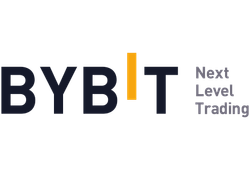
Free Airdrop Season 7 is LIVE! Answer fun questions or do simple tasks to earn rewards from the $30K BitDegree prize pool. Participate Now ! 🔥
If you’ve been active in online crypto spaces long enough, you’re probably familiar with the name “Bybit”; after all, it’s one of the most popular crypto exchanges, alongside Binance and Kraken. While there’s plenty of information available about the platform itself, less has been said about one of its integrated features – the custodial Web3 wallet. That’s precisely why I’m here with my Bybit Wallet review to fill in the gaps.
The feature is touted as one of the main pillars of the company’s foray into the Web3 sphere. Unlike Bybit’s traditional cold storage wallet system, which is mainly used to store funds offline, Bybit Wallet’s capabilities go far beyond providing a safe place to keep your crypto: it can connect to Web3 services while saving you the trouble of having to manage your own private keys.
Let’s take a closer look at this custodial hot wallet from one of the biggest household names in the crypto industry, then. What benefits does the Bybit Web3 Wallet offer, and where does it fall short? How to set it up? This Bybit Wallet review will answer all of those questions and more.
Verdict at a glance: Bybit Wallet is a custodial hot wallet that gives you access to Bybit’s Web3 integrations. It has a token swap function and competitive withdrawal fees. Bybit being responsible for managing your private keys makes it incredibly convenient but slightly less safe compared to the company’s other wallets – Keyless Wallet and Seed Phrase Wallet.
Pros
- Easy and convenient to use
- Multiple DeFi and dApp integrations
- IDO and staking
- Token swap function
Cons
- Locked to the Bybit exchange
- Not as secure as Bybit’s other wallets
Table of Contents
- 1. What Is Bybit Wallet?
- 2. Bybit Wallet Review: PROS
- 2.1. Easy and Convenient Option for Beginners
- 2.2. Web3 Integrations: NFTs, Apex Pro, and More
- 2.3. Staking and New Token Launchpad
- 2.4. Token Swap Function
- 3. Bybit Wallet Review: CONS
- 3.1. Exclusive to Bybit Web3 Platform
- 3.2. Less Secure Than Non-Custodial and Cold Wallets
- 4. Bybit Wallet Fees
- 5. Alternatives: Bybit Keyless Wallet & Seed Phrase Wallet
- 6. How to Use Bybit Wallet?
- 6.1. How to Create a Bybit Wallet
- 6.2. How to Add a New Wallet Address
- 6.3. How to Withdraw From Bybit Wallet
- 7. Conclusions
What Is Bybit Wallet?
Before we begin, some clarifications are in order. If, like most other readers of this Bybit Wallet review, you have at least a passing familiarity with its name, chances are you’re thinking of the Bybit exchange platform.
Bybit Wallet is one of the platform’s components (as most centralized crypto exchanges come with a built-in wallet), but it can also be used independently – for storing and swapping crypto coins and tokens, or for connecting to various dApps without engaging in traditional crypto trading.
I should also mention that, as of this Bybit Wallet review, the product has been renamed “Bybit Cloud Wallet” to distinguish it from the other two types of wallet Bybit has introduced: Keyless Wallet and Seed Phrase Wallet. For the sake of clarity, I’m going to continue referring to our wallet in question as “Bybit Wallet”.

Now that I’ve cleared up some potential confusion, let’s get to uncovering the technical details and aspects of this wallet!
The fact that it’s created and hosted by the Bybit exchange means that this is Bybit’s custodial wallet. It’s also a hot wallet – you can only use it when you’re connected to the internet.
One of Bybit Wallet’s most celebrated features, however, is its ability to become, as the company itself puts it, the “gateway to Web3”.
As the name itself suggests, Web3 is meant to be an upgrade from Web2 (the current version of the internet that addresses the issues increasingly plaguing online spaces today in 2024[1]. If Web2 is defined by centralized platforms, Web3 is the opposite of that: its vision is a completely decentralized internet. This can be achieved by harnessing the blockchain technology, including cryptocurrencies and tokens.

This is where the Bybit Web3 wallet comes into the picture. Far from only being a place to store, buy or sell your crypto coins, it offers a safe and convenient way to plug into the Web3 ecosystem and use its services while being spared the common hurdles users experience when faced with the decentralized blockchain activities, such as having to figure out how to find dApps or where to store their private keys safely.
The Bybit hot wallet allows you to carry out some basic crypto trading activities, such as swapping, lending, or staking coins, without having to visit the exchange platform itself (you will, however, need to use your Bybit account for this, as it’s not an independent wallet). It also gives you access to the NFT marketplace and a variety of GameFi and DeFi applications.
I’m not going to get ahead of myself and spoil all of those features too soon, though! Plenty of time for that in the following sections of this Bybit Wallet review.
Bybit Wallet Review: PROS
As you’ll see, there’s a lot to like about this wallet. Among other things, it offers convenience, various swapping, staking and listing functionalities, and a multitude of Web3 services. Let’s continue this Bybit Wallet review by examining each of those features in turn.
Easy and Convenient Option for Beginners
Out of all the benefits mentioned both on the company’s official website and in other Bybit Wallet reviews, convenience is easily the predominant one.
Most of it has to do with the fact that, as I already mentioned, Bybit is a custodial wallet. Have you ever lost or misplaced your apartment keys before? Countless times, probably! Imagine if there was a magical assistant who’d take care of your keys for you: keep them in a safe place and hand them over to you whenever you need them. This is exactly how custodial wallets function: they take over the responsibility of storing and managing private keys on their users’ behalf.
Not having to worry about losing access to your wallet is just the beginning. Bybit Wallet provides a user-friendly experience at every step – from a wallet creation process that takes only three clicks! And that’s no exaggeration. Fully integrated with the Bybit exchange, this wallet allows you to start using the Bybit Web3 wallet immediately if you already have a Bybit account, without any separate setup required.

After that, you can download the Bybit Wallet extension (only available for the Chrome browser, unfortunately) to connect this wallet to dApps.
Now, if you want to learn how to use it – specifically, how to send crypto from Bybit to another wallet or how to withdraw from your Bybit wallet – there are a few additional steps to keep in mind. But we’ll get to the “how-to” part of this Bybit Wallet review later. For now, let me just reiterate that this wallet is incredibly beginner-friendly in most respects.
If you’re a novice in the world of crypto and would prefer some more guidance, you’re in luck: the official Bybit website has an extensive help center with tons of articles and other educational resources that can answer all of your questions.
Speaking of convenience, I should also mention the lack of KYC verification. Like Bybit’s other two wallets – which I’ll discuss in more detail later – Bybit Wallet doesn’t require you to verify your identity before you can use it. While this may not be ideal from a security standpoint, many users will likely appreciate avoiding the extra hassle of uploading documents and waiting for verification.
Web3 Integrations: NFTs, Apex Pro, and More
The Bybit exchange doesn’t come to the world of Web3 empty-handed: it brings a number of NFT, DeFi and GameFi integrations of its own!

Here are the four dApps you can check out that are part of the Bybit Web3 ecosystem and are easily accessible from Bybit’s Web3 portal:
- NFT Marketplace: By now, NFTs have become a quintessential and iconic addition to the Web3 sphere. The good news is that Bybit Wallet lets you buy and sell NFTs right there on its own decentralized NFT marketplace aggregator!
- Apex Pro: While the main Bybit exchange is centralized, it has its own decentralized counterpart, too. Apex Pro is a permissionless and non-custodial DEX. It allows you to trade with lower gas fees and execute more efficient transactions.
- Mantle: A modular, high-performance Ethereum Layer 2 network that lets you design your own dApps.
- Yeeha: A revolutionary gaming platform that bridges the gap between traditional gaming and GameFi - blockchain-enhanced gaming that combines NFTs, blockchain technology and the play-to-earn model.[2]
Amateur crypto traders and those who’ve only just started taking their first steps into the world of Web3 would probably be more interested in trying their hand at Web3-powered gaming first, while more experienced crypto enthusiasts would no doubt be excited to check out Apex Pro or build their own dApps on Mantle. There really is a little bit of everything in here for everyone!
Latest Ledger Nano X Coupon Found:For a limited time only, get Top-rated Ledger bundles for yourself and your loved ones with a 10% Ledger discount code. Take advantage of this valuable Ledger deal NOW!
Staking and New Token Launchpad
Staking is a popular feature on many crypto exchanges today. It involves keeping your coins on the platform for a specified period in exchange for a reward, typically in the form of free tokens. In decentralized exchanges, staking works slightly differently – you don’t stake your holdings on the platform itself but rather in “liquidity pools” that facilitate peer-to-peer transactions.
The centralized Bybit exchange already offers staking, but with the Bybit Web3 wallet, you can try out the decentralized Web3 version of staking, too! The Bybit Web3 ecosystem gives you access to multiple staking pools. You won’t have to hunt them out yourself, either – the company’s already done the work for you, featuring a carefully reviewed and curated selection of staking pools on its Web3 Staking page.
If, after finishing reading this Bybit Wallet review, you’re curious to try staking, all you have to do is go to the Bybit website, find Earn on the top menu bar, click Staking, and connect your Bybit Wallet. You’ll find all the available staking pools listed there, and you can pick any of them with just a click!

That’s not the only feature you’ll find on Bybit’s Web3 Earn section, though.
As one of the most popular ways for startups to raise capital, crowdfunding has unsurprisingly found its way into the world of crypto projects, as well. An Initial DEX Offering (IDO) is a decentralized and permissionless method of crowdfunding where a new project is launched directly on a decentralized crypto exchange platform. IDOs are often touted to be a safer and more efficient alternative to Initial Coin Offerings (ICOs) that take place on centralized exchanges.
As a user, you can subscribe to IDOs by going to the IDO page on the official Bybit website. You can’t just buy your token of choice directly, though – the tokens get allocated randomly via a smart contract.

Or, rather, not quite randomly – your likelihood of receiving tokens depends on your IDO score. The higher your score, the more lottery tickets you get, and the higher your chances of winning the tokens. You can boost your IDO score by completing tasks or meeting certain criteria, such as holding assets, adding specific tokens to your Bybit hot wallet, or inviting new participants to IDO.
If luck is on your side and you end up winning your share of tokens, you can claim them during the redemption period. Make sure to hold some USDT or USDC tokens (for BNB or ETH-based projects, respectively) to redeem them.
Token Swap Function
“Trading” is usually the word that goes hand in hand with cryptocurrency. Unfortunately, it can get a tad complicated at times. A lot of veteran traders can’t get enough of those intricacies and will gladly spend hours deciphering the candlestick charts to maximize their pay-off – but what about the people who simply want to exchange one coin for another without getting bogged down in all those complexities which can easily make crypto trading look like rocket science?
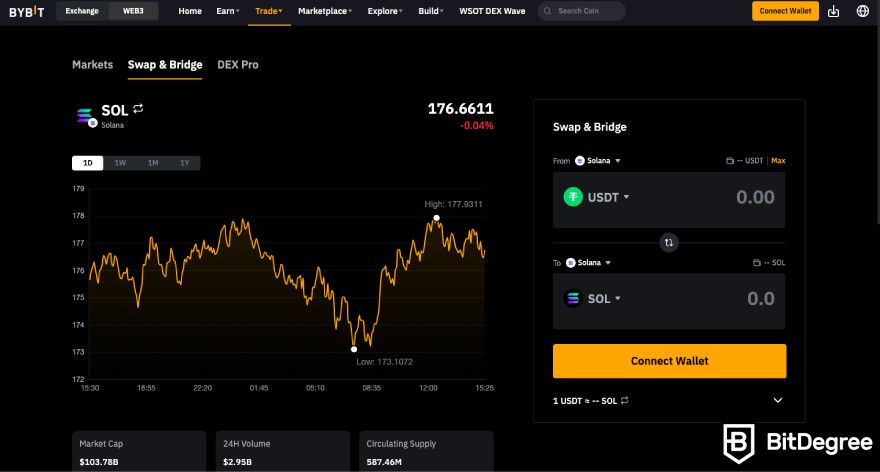
This is why many exchanges, including Binance and Kraken, now offer a “swap” feature that allows users to – yes, you guessed it – swap one coin for another quickly and easily, without worrying about which type of order to place or finding the best time to buy or sell.
The Bybit Web3 ecosystem makes it easy with their multi-chain DEX aggregator offering over 400 DEXs to swap tokens through! Simply go to the Swap page on the official Bybit website, select the coin or token you want to exchange, and let your Bybit Wallet do the rest! Don’t forget to make sure your Bybit Wallet balance is sufficient to complete the transaction, though.

Did you know?
All Crypto wallets may look similar to you but they're NOT all the same!
Bybit Wallet Review: CONS
Now that we’ve explored the best features this wallet has to offer, let’s round out this Bybit Wallet review by shedding some light on its shortcomings as well.
Exclusive to Bybit Web3 Platform
One of the main draws of decentralization is portability. Having complete control over your data means you can easily transfer it from one platform to another. This holds true not just for the tokens you have in your wallet but the wallet itself, as well.
Unfortunately, as a custodial wallet, Bybit Wallet has no such option. You can’t import or export your private keys or seed phrases from/into other wallets. This means that Bybit Wallet is exclusive to the Bybit Web3 platform.
This wallet being sandboxed in the Bybit Web3 ecosystem also means you can only connect it to dApps that are integrated with it. You can find the list of all available dApps on Bybit’s official Web3 platform. The selection isn’t that narrow, and the company keeps adding new integrations, but still, it’s certainly a drawback that Bybit Wallet isn’t as versatile as non-custodial hot wallets that can connect to dApps independently.
Less Secure Than Non-Custodial and Cold Wallets
Another potential flaw I should mention in this Bybit Wallet review is a comparably lower security level.
Even though, just like other top exchanges such as Binance and Kraken, Bybit prides itself on its strong focus on security, custodial wallets don’t exactly have the upper hand in this area. In this case, convenience is a double-edged sword: not having to manage your private keys yourself necessarily means entrusting them to a third party – in this case, a centralized crypto exchange platform that’s susceptible to things like hacker attacks or server downtime.
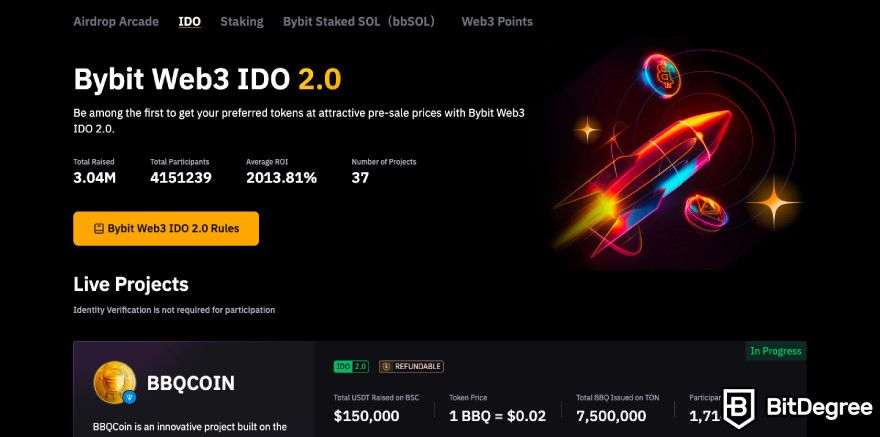
Being a hot wallet, Bybit Wallet is, technically, not as secure as cold (or hardware) storage solutions, such as Ledger Nano X, Trezor Safe 5, or Ledger Nano S Plus, either. Cold wallets function more like physical storage vaults – they can't be accessed online in any way, making them 100% immune to hacking attempts or other cybersecurity threats.
Still, this assessment is perhaps more uncharitable than it should be because it only takes into account external (online) hazards. As you and every other reader of this Bybit Wallet review is well aware, we can be our own worst enemy sometimes. No matter how meticulous you are about storing your private keys or seed phrases, the risk of losing them is never zero. Or – let’s be honest – probably a good deal more than zero!
With that in mind, it’s easy to see why many people would rather trust a reputable company like Bybit to store their private keys and seed phrases for them. High-powered investors with especially large holdings might understandably prefer to invest in a sturdy hardware wallet, but for your average crypto trader or Web3 enthusiast, Bybit Wallet’s security should by no means be a dealbreaker.
Bybit Wallet Fees
This Bybit Wallet review wouldn’t be complete without covering the fees– so, without further ado, let’s dive into this section and find out how much it costs to use Bybit Wallet!
The wallet itself is free to use; all the costs are associated with transaction or withdrawal fees.
The aforementioned swap function comes with a flat 0.1% network fee, which is quite competitive compared to most other wallets and exchanges.
On the other hand, if you’re looking for a conventional trading experience instead, Apex Pro uses a Maker-Taker model: it charges different fees depending on whether a user is a “maker” who adds more liquidity to the platform by placing limit orders and setting their own price, or a “taker” who places market orders and agrees to buy or sell coins immediately at their current price.
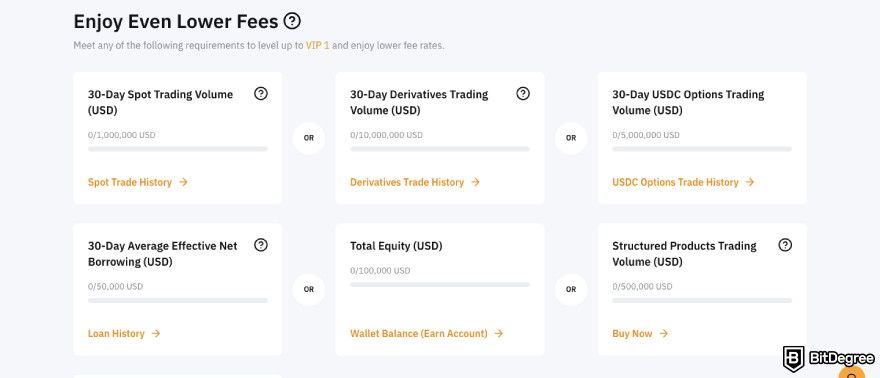
This approach is somewhat unusual for a decentralized crypto exchange, as the maker-taker model is typically found on centralized exchanges like Binance and Kraken, but it’s not unheard of.
Apex Pro's maker fees are at 0.02%, and taker fees are at 0.05%.
The fees usually associated with wallets are, of course, withdrawal fees, as withdrawals take place on the wallet itself.
You’ll probably be happy to know that Bybit doesn’t charge you for internal transfers – that is, transfers from one Bybit Wallet address to another. That’s certainly a good way to encourage users to stay on the platform!
As is the case for most other exchanges and wallets, deposits are free, while withdrawals are subject to varying fees depending on the specific coin or token.
Alternatives: Bybit Keyless Wallet & Seed Phrase Wallet
You’ve seen these two names scattered around this Bybit Wallet review – now it’s time to explain what they are and how they differ from our wallet in question!
Keyless Wallet and Seed Phrase Wallet are two other wallets created by Bybit. They’re quite different from Bybit Wallet (currently called Cloud Wallet) and would be more appealing to users with different needs. Let’s take a closer look at those two alternatives, then.
Keyless Wallet, like Bybit Wallet, requires a Bybit account but no KYC verification and can be used to connect to Web3 services. Staking and IDO will be supported soon.

But this is where the similarities end. Keyless Wallet is non-custodial, and its selling point is that, unlike traditional wallets, it stores your private keys in several locations, not just one. It divides your private keys into two shares: one of which is stored by Bybit, the other on the user’s cloud drive. This unique approach adds an extra layer of security.
The Seed Phrase Wallet offers another way to protect your private keys by converting them into a seed phrase of 12, 18, or 24 words. This gives users full control over their wallet access but also full responsibility: you must determine how to store the seed phrase securely (preferably offline).

This potential hassle earns you the highest level of security, though, and the benefit of portability, as well: unlike the other two wallets, Seed Phrase Wallet isn’t chained to the Bybit Web3 ecosystem, meaning you can import your seed phrases from other wallets or, likewise, export them.
As you can see, Bybit has certainly spoiled its users for choice! If, after reading this Bybit Wallet review, you decide that one of the other two alternatives is a better fit for you, feel free to try them instead.
How to Use Bybit Wallet?
Enough theory – it’s time to take this Bybit Wallet review to the next level by giving you some practical tips. Being aware of Bybit Wallet’s place in the Bybit Web3 ecosystem and the perks it offers is all very well, but what if, at this point, you just want to find out how to send Bitcon from Bybit to another wallet? Fear not – you’ll find out soon enough in this section of my Bybit Wallet review!
How to Create a Bybit Wallet
As I’ve already said, the process is incredibly simple and easy! It takes only three steps.
Step 1: Go to the official Bybit website and click “Connect Wallet” at the top right corner.

Step 2: Find “Bybit Cloud Wallet” on the list and click “Login”.
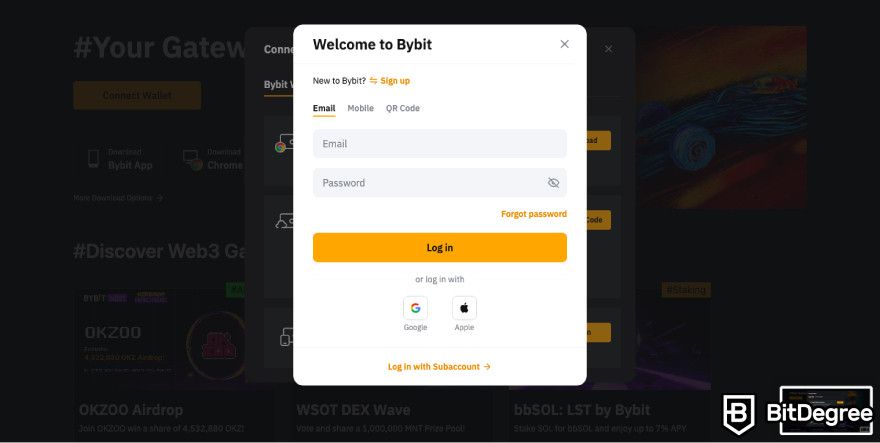
Step 3: Click "Create Now" to create a new Bybit Cloud Wallet.

Now, wait for Bybit to redirect you to your new wallet!
How to Add a New Wallet Address
Let’s say you have some coins in your Bybit Wallet that you want to transfer to another wallet instead.
There are two different types of cross-wallet transfers on Bybit: transfers to the wallet of another Bybit account (also called internal transfers) and transfers to another third-party wallet. An external transfer means your funds will be transferred from your Bybit Wallet address to that of another wallet.
This is why you’ll first need to add the address of the wallet you want to send your crypto to.
Step 1: Make sure your Bybit Wallet balance is above zero.
Step 2: Set up Google Two-Factor Authentication on your Bybit account.
Step 3: Go to your wallet management page or click “Manage Withdrawal Addresses” on the Account and Security page.
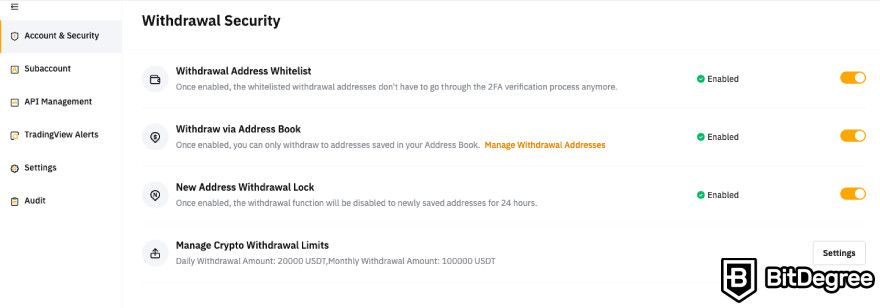
Step 4: Click the “Add” button at the top right corner to add a new wallet address. You can also click “Add in Batches” if you want to add multiple addresses.
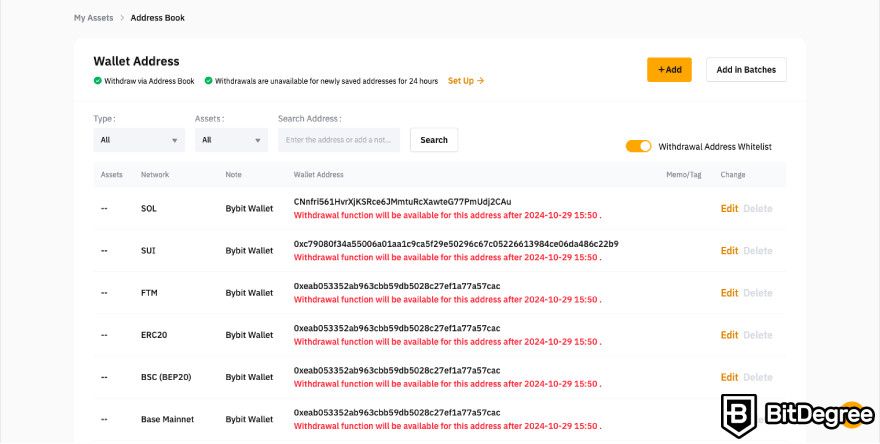
Step 6: Fill in your withdrawal wallet address details.
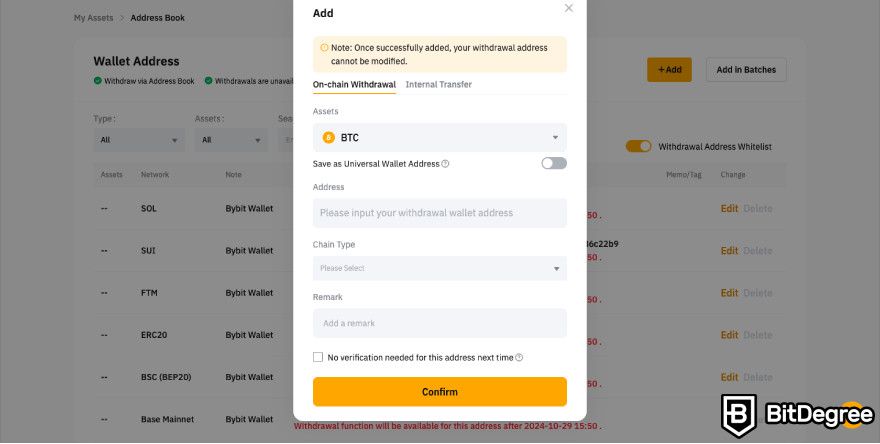
Step 7: Click “Confirm”.
If you want to add an Internal Transfer account, simply enter your email address, mobile number, or UID of the Bybit account to which you would like to withdraw.
How to Withdraw From Bybit Wallet
Now that you’ve added an external wallet address, you can send your crypto to that wallet.
Step 1: Go to your account and click "Withdraw".
Step 2: Select the coin you want to withdraw.
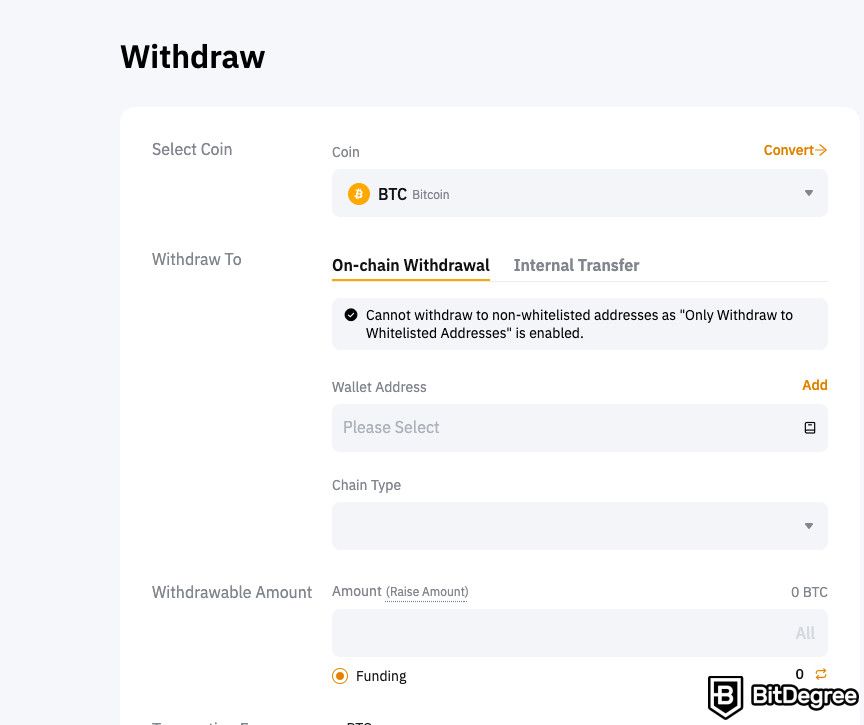
Step 3: Enter the receiving wallet address, the amount you want to withdraw, and your preferred gas fee – slow, average, or fast (you’ll be able to see how much each type of transaction would cost), then click “Next”.
Step 4: Check if all the details are correct, set the transaction type to “Send”, and click “Confirm”.
Step 5: Click “Send Verification Code”. Check your email and enter the code you received.
You’re all set!

- User-friendly design
- Robust security
- Long battery life

- A brand-new design
- Industry-leading security
- Coin, token and NFT storage

- Supports 1,000+ crypto assets
- Easy navigation
- Open-source
Conclusions
Let’s wrap up this Bybit Wallet review with a little recap! Bybit Wallet is a custodial hot wallet created by the Bybit exchange (one of the top-rated crypto exchanges at the time, alongside Binance and Kraken). It ties together Bybit’s Web3 ecosystem by letting you connect to the offered dApps and other integrated Web3 services through the Bybit Wallet extension.
Bybit Wallet stands out as an attractive option for beginners due to its convenience. As a custodial wallet, it manages your private keys, so you don’t have to. Beyond simply storing your coins and tokens, Bybit Wallet also provides an easy way to swap one coin or token for another without the complexities of traditional trading, as well as access to a variety of NFT, DeFi, and GameFi services.
Still, if you’re not the intended audience, there might be better options out there. As a hot wallet, Bybit Wallet isn’t as secure as cold wallets such as Ledger Nano X, Trezor Safe 5, or Ledger Nano S Plus. Moreover, it only works with a Bybit account, meaning you won’t be able to transfer your private keys to another wallet. Traders who expect the highest level of security and full ownership of their wallet could check out Keyless Wallet or Phrase Wallet instead.
The content published on this website is not aimed to give any kind of financial, investment, trading, or any other form of advice. BitDegree.org does not endorse or suggest you to buy, sell or hold any kind of cryptocurrency. Before making financial investment decisions, do consult your financial advisor.
Scientific References
1. J. Bambacht and J. Pouwelse: ‘Web3: A Decentralized Societal Infrastructure for Identity, Trust, Money, and Data’;
2. J. Proelss, S. Sévigny, and D. Schweizer: ‘GameFi: The perfect symbiosis of blockchain, tokens, DeFi, and NFTs?’.




